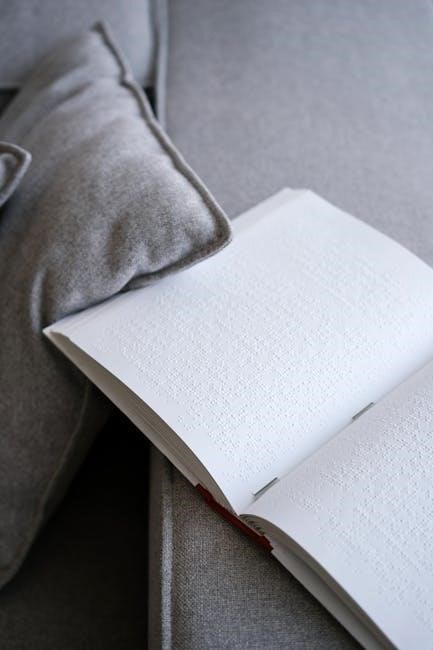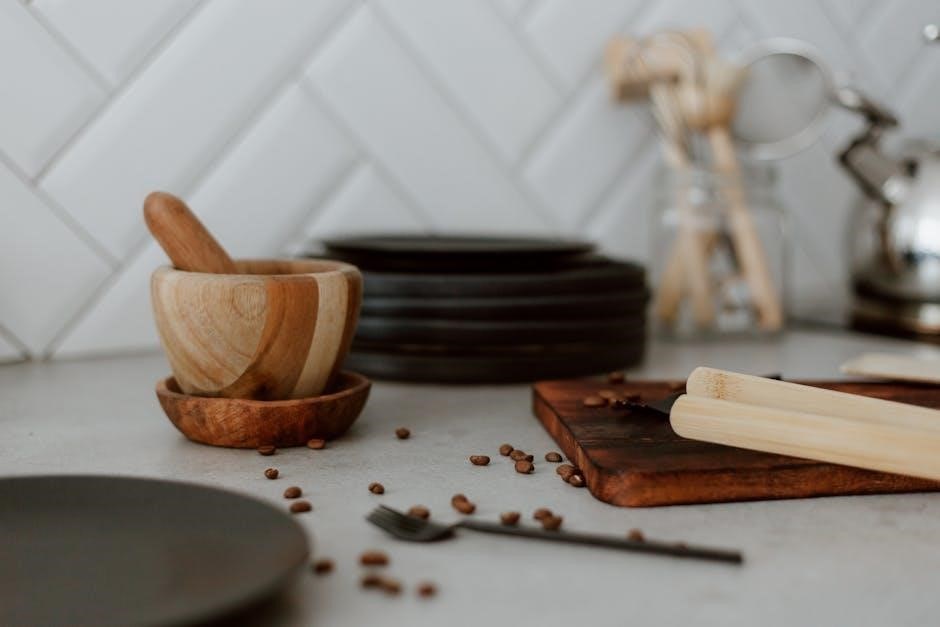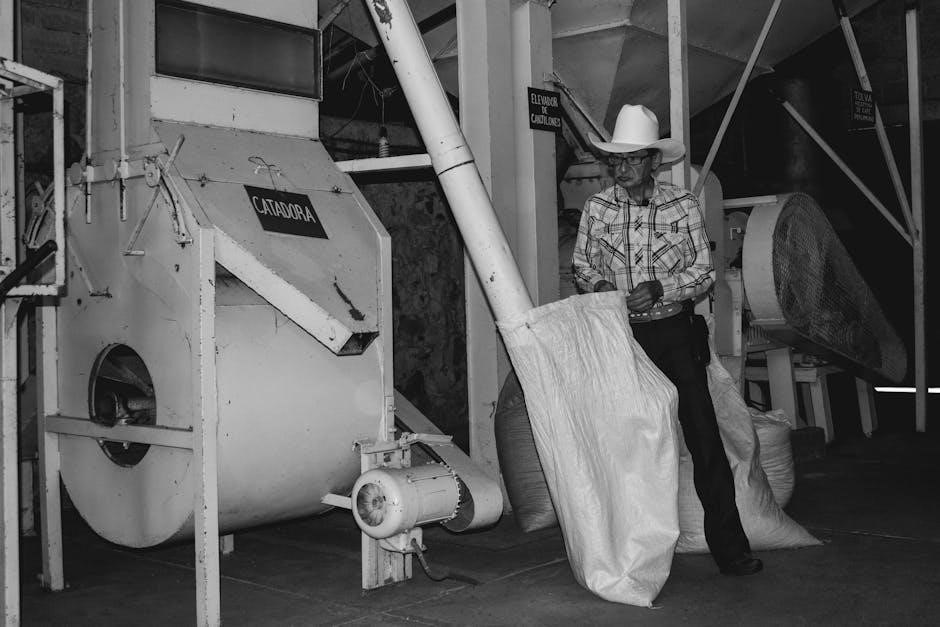Coffee grinding is an art that requires technique and patience to perfect‚ with various methods and tools available to achieve optimal flavor and aroma‚ using different grinders and grind sizes effectively always.
Importance of Grind Size
The grind size of coffee is a crucial factor in determining the quality of the brew‚ as it affects the extraction of flavors and oils from the coffee beans. A grind that is too fine can result in over-extraction‚ leading to a bitter taste‚ while a grind that is too coarse can result in under-extraction‚ leading to a weak or sour taste. The ideal grind size will depend on the brewing method being used‚ with different methods requiring different grind sizes to produce the optimal flavor and aroma. By using the correct grind size‚ coffee lovers can unlock the full potential of their coffee beans and enjoy a more satisfying and flavorful cup of coffee. The relationship between grind size and brewing method is complex‚ and understanding this relationship is essential for producing high-quality coffee. Proper grind size is essential for a good cup of coffee.
Overview of Coffee Grinding Techniques
Coffee grinding techniques involve various methods and tools to grind coffee beans‚ each with its own advantages and disadvantages. The techniques used can affect the flavor and aroma of the coffee‚ and different techniques are suited to different brewing methods. Some common techniques include grinding beans just before brewing‚ using a consistent grind size‚ and adjusting the grind size based on the brewing method. Additionally‚ the type of grinder used can also impact the flavor and aroma of the coffee‚ with some grinders producing a more consistent grind than others. By understanding the different coffee grinding techniques‚ coffee lovers can experiment and find the method that works best for them. This can involve trying out different grinders‚ grind sizes‚ and brewing methods to find the perfect combination. With practice and patience‚ anyone can master the art of coffee grinding. Proper technique is essential for great coffee.

Types of Coffee Grinders
Coffee grinders come in various types‚ including manual and electric‚ each with unique features and benefits always available for different users and purposes effectively.
Hand Grinders
Hand grinders are a popular choice for coffee enthusiasts who value a traditional and manual approach to grinding their coffee beans. These grinders typically consist of a handle‚ grinding mechanism‚ and container to collect the grounds. They offer a high degree of control over the grind size and are often preferred for their ability to produce a consistent and flavorful grind. Hand grinders are also relatively inexpensive and easy to clean‚ making them a great option for those who are new to coffee grinding or who prefer a low-maintenance approach. Additionally‚ hand grinders are often more portable than electric grinders‚ making them a great choice for travel or camping. Overall‚ hand grinders are a great option for those who want a traditional and manual coffee grinding experience. They are also a great way to develop a sense of connection to the coffee-making process.
Blade Grinders
Blade grinders are a type of electric grinder that uses spinning blades to chop coffee beans into smaller pieces. They are often less expensive than other types of grinders and are widely available. Blade grinders are relatively easy to use‚ simply add coffee beans and grind until the desired consistency is reached. However‚ they can generate heat which can damage the coffee beans and affect the flavor. They also tend to produce a less consistent grind than other types of grinders‚ which can lead to uneven extraction. Despite these limitations‚ blade grinders can still produce a good cup of coffee and are a good option for those who are new to coffee grinding or who want a low-cost grinder. They are also relatively small and easy to store‚ making them a great option for those with limited kitchen space. Overall‚ blade grinders are a simple and affordable option.
Burr Grinders
Burr grinders are a popular choice among coffee enthusiasts due to their ability to produce a consistent grind. They work by crushing the coffee beans between two abrasive surfaces‚ known as burrs‚ which can be adjusted to achieve the desired grind size. This type of grinder is considered to be more precise than blade grinders and can produce a wider range of grind sizes. Burr grinders are also less likely to generate heat‚ which can damage the coffee beans and affect the flavor. They are available in both manual and electric models‚ with the manual models being a great option for those who want more control over the grind. Overall‚ burr grinders are a great choice for those who want a high-quality grind and are willing to invest in a more expensive grinder. They offer a high degree of precision and control‚ making them a favorite among coffee connoisseurs.

Coffee Grinding Tips
Effective grinding techniques enhance flavor and aroma‚ using fresh coffee beans and proper storage methods always ensures optimal grinding results and flavor preservation always with great coffee grinding skills.
Choosing the Right Grind Size for Brewing Method
The grind size of coffee is crucial for the brewing method‚ as it affects the flavor and aroma of the coffee. Different brewing methods require different grind sizes‚ and using the right grind size is essential for optimal flavor extraction. For example‚ a finer grind is required for espresso‚ while a coarser grind is suitable for French press. The grind size also depends on the type of coffee bean and the roast level. A darker roast requires a slightly coarser grind than a lighter roast. By choosing the right grind size for the brewing method‚ coffee lovers can ensure a perfect cup of coffee every time. This requires some experimentation and adjustment to find the ideal grind size for each brewing method. With practice and patience‚ coffee enthusiasts can master the art of grind size selection and enjoy a perfectly brewed cup of coffee.
Influence of Coffee Beans on Grinding
Coffee beans play a significant role in the grinding process‚ as their characteristics can affect the grind size and quality. The type of coffee bean‚ its origin‚ and processing method can influence the grind. For instance‚ Arabica beans are generally harder than Robusta beans‚ requiring a slightly different grinding approach. The moisture content of the beans also affects the grinding‚ as beans with higher moisture content are more prone to clumping. The age of the beans is another factor‚ as freshly roasted beans are more fragile and require a gentler grind. Additionally‚ the bean’s density and oil content can impact the grind‚ with denser beans requiring a finer grind and oilier beans requiring a coarser grind. Understanding these factors can help coffee enthusiasts adjust their grinding technique to bring out the best flavors and aromas from their coffee beans. This knowledge is essential for optimal grinding.

Technical Relationship Between Grinding and Extraction
Grinding affects extraction rates‚ with optimal grind sizes yielding balanced flavors and aromas‚ using various techniques to achieve perfect extraction always matters.
Understanding Extraction and Its Impact on Flavor
Extraction is a critical process in coffee brewing‚ as it determines the flavor and aroma of the final product. The rate of extraction is influenced by various factors‚ including grind size‚ water temperature‚ and brewing time. Understanding how these factors interact is essential to achieving optimal extraction and flavor. By controlling the extraction process‚ coffee enthusiasts can bring out the unique characteristics of their favorite coffee beans. The relationship between extraction and flavor is complex‚ and small changes can significantly impact the taste of the coffee. As a result‚ coffee grinding and brewing require a delicate balance of art and science to produce a perfect cup. With the right techniques and equipment‚ anyone can master the art of extraction and enjoy a flavorful cup of coffee. Proper extraction is key to unlocking the full potential of coffee.

Best Practices for Manual Grinding
Manual grinding requires patience and technique to achieve optimal flavor and aroma‚ using correct grind settings and consistent grinding motion always yields better results effectively.
Techniques for Optimal Flavor and Aroma
To achieve optimal flavor and aroma‚ it is essential to use the right techniques when grinding coffee manually. This includes using the correct grind settings‚ applying the right amount of pressure‚ and maintaining a consistent grinding motion. The goal! is to extract the perfect amount of flavor and oil from the coffee beans. By mastering these techniques‚ coffee enthusiasts can elevate their coffee experience and enjoy a more flavorful and aromatic cup of coffee. Additionally‚ using fresh and high-quality coffee beans can also make a significant difference in the flavor and aroma of the coffee. With practice and patience‚ anyone can develop the skills needed to grind coffee like a professional and enjoy the perfect cup of coffee every time‚ with a rich and full-bodied flavor that is sure to please even the most discerning coffee lovers.
